YouTube is now bigger than ever, and there are no signs of slowing down. The platform reaches more 18-34 and 18-49 year-olds than any cable network in the U.S., and one of the more popular things to do these days is to start vlogging.
As more and more people watch more and more channels and creators, it’s natural to think “Hey, this looks really fun! I want to make a vlog channel!” And while it is, on the surface, pretty straightforward, there are definitely some things that some people don’t know.
While there may not be a step by step guide to become a YouTube star, we can walk you through how to start a vlog on your new (or existing) YouTube channel. Front to back, soup to nuts, to the window, to the wall. It’s as easy or complex as you make it, and we’ll point you in the right direction for your first video.
Contents
- 1 Tips on how to start a vlog
- 2 What is a vlog?
- 3 Why should I vlog?
- 4 Do you need a YouTube channel to vlog?
- 5 What genres, styles, or types of vlogs are there?
- 6 Picking the best vlogging equipment for you
- 7 Best video editing software for vlogging (the professional/popular standards)
- 8 Best video editing software alternatives for vlogging (strong options against the popular choices)
- 9 Which video editing software is best for vlogging?
- 10 Vlog editing and pacing
- 11 Upload schedule and video length
- 12 Can you make money vlogging?
- 13 Vlogging tips
- 14 Final thoughts
Tips on how to start a vlog
- Determine what kind of vlog you want to start.
- Start your YouTube channel. Choose a great channel name, or start your personal brand under your own name.
- Get a camera–pretty much any video camera will work, but some are better vlogging cameras than others.
- Be consistent with how often you post your videos. Pick an upload schedule and stick with it.
- Stay authentic. Your audience will know if you’re faking it.
- Story, story, story. Even if a video isn’t scripted, per se, developing and maintaining strong narratives will help retain your viewers and keep them on the hook for more.
- Don’t be discouraged if growth is slow. These things take time. Successful vloggers aren’t created overnight!
- Make what you want to make, but it’s also okay to take criticism and feedback where it’s useful. Many people want to help out beginners along their journey because they were once there as well.
- Be engaged with your audience, especially in the YouTube comments and on Twitter. Make them part of your journey!
- Video quality is a good goal to aspire to, but it’s not the requirement.
- Most importantly, have fun! Don’t get burned out too quickly, and remember that the point is to be creative and have fun! A fun video is a good video!
And now, on with the expanded version!
What is a vlog?
I know that if you’re reading this article, you probably already know what a vlog is, but we’ll cover it anyway. A vlog, simply put, is a combination of video blog (or video log). A blog is a combination of web log. A web log is basically “a website on which one person or group puts new information regularly, often every day”. So through the shortening of a shortening term, basically a vlog is a video series that is updated frequently.
The predominant home for vloggers is on YouTube. With such a huge viewer base and excellent discoverability as the world’s second-largest search engine, it’s easiest to grow a YouTube channel. Uploading from a non-mobile camera is also easiest here, making it a favorite for vloggers.
There are no real rules as to what a vlogger’s channel needs to be about, so you can really cover anything you want. There are vloggers who create content in all sorts of niches–tech, photo/video, beauty, lifestyle, comedy, family, you name it. The list is basically endless, but these cover some of the more popular genres out there.
The important part of starting a vlog, however, is to tell a story. Your story. Whether that is the step by step motions through your day or picking out a three-act narrative (Act 1: Setup – Act 2: Conflict – Act 3: Resolution) like Casey Neistat ascribes to, the key is to provide something useful and engaging to your audience. If you can bring someone along and make them feel connected to you and your story, you’re on the right path.
Vlogging style
Vlogs are essentially a series of videos that document an ongoing story of sorts. A person’s life, a long project, a particular topic. What you decide to build your YouTube channel around is entirely your choice, but it’s basically a means of bring your audience along for whatever ride you’re embarking on.
But if you’re just getting started learning how to start a vlog, you may be unsure as to what aesthetic or style you want your videos to take. There’s no right or wrong answers here as long as it fits your personal story and style, but there are some commonalities you’ll see out there.
Even on YouTube, vlogs are typically rougher, not so polished, and is a bit more intimate than, say, a scripted or more formal video. Instead of reading from your phone or off of a teleprompter, you’re more free-flowing. You’re talking with your audience, not at them.
There’s less emphasis on video/audio quality than a typical well-produced video segment, but that’s primarily due to the run-and-gun nature of a lot of vloggers. Some creators use a lot of cinematic b-roll to break up their a-roll dialog, whereas others will stick more to the a-roll and more topical b-roll.
But this is definitely changing–take a look at YouTubers like Peter McKinnon and Casey Neistat going hard on that sweet, sweet cinematic b-roll as a regular part of their vlogs. This means that more and more vloggers, in general, are seeing this and feeling like this is where their own video needs to go. It’s a great exercise in filmmaking, but it’s not necessarily critical for a good vlog channel.
Anyone who sticks with vlogging for a good period of time will end up developing their own style and feel after a while. When starting out it may be useful to try and imitate some things you like from the vloggers you look up to, but only as a learning tool, or training wheels while you find your own voice. Don’t stress about it, just make your videos.
Vlog vs blog
This one’s pretty simple. If a vlog is a “video blog”, and a blog is, well, a blog, the difference is that one is a video and one isn’t. In our opinion, a vlog can be classified more as entertainment, whereas a blog is (typically) more informational these days.
This is definitely not any sort of hard and fast rule, but it’s been our observation over the years. Yes, there can be informational videos out there (and there are a LOT), but vlogs tend to aim for bringing the viewer along for the ride, not necessarily teaching them how to do something in detail.
The other aspect of this question is: Which one should I do? And the answer is: Why not both?
Most people in the YouTube or blogging space will agree that if you have a blog, you should also have a YouTube channel and vice versa. This has become a much bigger step in gaining traffic from one to the other in recent years.
Think about it this way. If you blog, you can definitely vlog about your blogs. Even if it’s just making recap videos, it’s possible. This may be tricky depending on what you blog about, but if it can tie in or be a companion piece, it’s not a bad idea.
The YouTube channel will funnel traffic to the blog site, and vice versa. You can make articles about your videos, elaborating on things that were missed, make a brief mention or add tips you didn’t cover in the video. You could also just make a transcription of the video into a blog post.
If you run a business, you could actually benefit from this strategy as well. You can post your videos on your site as blog content, and cross-link between the two.
You don’t need to do one if you do the other, but they definitely don’t hurt each other and will likely complement the other. Thankfully, learning how to do one is pretty similar to the other, just in a different–yet complementary–medium.
Why should I vlog?
Easy. Because you have something to share with the world. Or because you want to get your personal message out there. Or because you want to hold yourself accountable to something. Or because you’re bored and have a ton of free time.
Take your pick. These (and more) are all valid answers. But really, when it comes down to it, you should vlog if you want to. If you find yourself thinking “Hey, these experiences are really cool, maybe someone else will feel the same!”, there’s your answer. There are a lot of viable reasons to start a vlog.
Creating a second YouTube channel
This is especially true for content creators who already put out regular non-vlog YouTube videos. Starting a vlog is a fun way to connect with your audience, bring them along through your struggles and success, and form a stronger connection with your viewers.
Whether it’s travel for gigs, behind the scenes (or BTS) videos to pull back the curtain on your main channel videos, or just random occurrences that you think your fans will enjoy, it’s more video at (hopefully) lower effort/time levels than your main content. It’s an excellent way to add more video to your other social media channels.
Documenting your journey
For those who don’t necessarily have an established audience, don’t worry about it. Vlogging is a great way to document your growth as you become a YouTube creator. It will also give you much-needed practice in front of and behind the camera, as well as in post-production. Who knows, maybe one of your videos will gain serious traction for one reason or another, and that can help push your main YouTube channel.
Committing to a vlog is also useful because of the first word in this sentence: Committing. If you have a vlog that you’re dedicated to maintaining, it will help hold you accountable. It will guarantee that you have something to create.
Vlogs for a business
Believe it or not, a business could absolutely benefit from vlogs, and it may not even take much more effort or cost to do so.
You can discuss your products or services, as well as the goings-on behind the scenes of your company. This would absolutely serve to put some personality and relatability to your company’s presence online.
With a business channel, creating content can be woven into the day-to-day operations and provide an insight into your business and what customers can expect if they hire or interact with your business.
Without these videos, customers may not be exposed to your company as often as with it, which would make it easier to keep customers informed as they await a new video they want to watch each week.
Vlogging channels can help the creative process
And creating is key. Not enough other stuff going on to make a vlog interesting? Find something to fulfill that need! Go on an adventure. Make a new friend. Try that new restaurant across town that your friend said you absolutely needed to try. Start work on a piece of content you’ve been meaning to start for months but just haven’t yet.
All of this will help your creative endeavors on both the vlog and main content side of things (if that’s how you roll, of course). But overall, even if you just want to vlog and nothing else, it will give you something to work toward. Making things is amazing.
Why shouldn’t I vlog?
I want to say that there are literally no good reasons not to vlog, but that’s a pretty foolish stance to take, in reality. Even if you think it would be a lot of fun, some things will just make it not practical.
How many other projects do you have going on? If you’re swamped with work, family, more work, and on and on, would you have time to start vlogging?
Maybe filming the videos, yes. But will you really have time to sit down and edit? If you’re already very busy, this might introduce extra stress into your already packed schedule.
Are you thinking that you should vlog, but just really don’t like the idea of it? This is a definite answer then. If you don’t like it, don’t do it. There’s nothing wrong with knowing that it could help your main gig, and just hate the concept of having to make those videos despite that knowledge.
Even if you forced yourself to do it, your videos will definitely come off as not genuine to your fans. This would be a net loss for your time and productivity, so might as well skip it.
It’s possible that your target audience from your main channel may not care about a second vlogging channel. Or the opportunity cost of making a second channel just for fun is too steep to not work on your primary channel.
There are definitely a few reasons to not become a YouTube vlogger–aside from literally having zero time or just not liking the idea. The one thing that shouldn’t stop you, however, is gear. Especially gear, but more on that later.
Do you need a YouTube channel to vlog?
In short, no–you could always vlog on Instagram with Stories and Reels, on Snapchat, on Facebook Stories, on TikTok, and on and on. Any sort of social media with a decent user base should work.
Just make sure there’s a good discovery and sharing engine if you don’t already have an established audience. You may also have more difficulty monetizing some other platforms, so keep that in mind if your goal is to make money.
That said, YouTube is definitely the go-to video sharing platform, and due to the enormous viewer base, it’s probably easiest for most vloggers to build an audience and get started with a YouTube channel as opposed to somewhere else. And if you don’t have one yet, creating a YouTube channel is quite easy.
As YouTube is the second largest search engine site on the web, it’s recommended that you start your vlog on YouTube. If you’re a niche vlogger, your target audience will be able to find you more easily because of that search advantage.
People want to find videos where they’re already watching videos–YouTube is definitely that place.
Also, from a technical standpoint, it’s also much easier to upload from a non-mobile device like a DSLR or mirrorless to YouTube as opposed to other social media channels.
What genres, styles, or types of vlogs are there?

There aren’t really a fully defined group of topics or methods, but that’s sort of the beauty of a vlog. They aren’t typically bound by a bunch of rules or limitations. But there’s definitely some that are more common than others that you may or may not be familiar with.
And yes, some will call nearly any video on YouTube with a person just talking in it a vlog, but for the sake of this article, we’re going to be somewhat specific. This (definitely not comprehensive) list won’t include straight-up educational/tutorial content, your typical “scripted” YouTube videos, gamer channels, and some other niches that are sometimes referred to as vlogs.
Lifestyle vlog
Lifestyle vlog (and subsequently a lifestyle blog) is a fairly catch-all genre of vlogging. Basically, a lifestyle vlog is an amalgamation of multiple specific niches that may make up a person’s core interests. There could be a mix of fashion, beauty, life hacks, getting organized, photography, you name it.
A lifestyle vlog is really just one person documenting his or her day/week with whatever ideas or projects or errands happen to come across their schedule for that day. There’s no specific format or niche to reign in the content, which is both a good and bad thing.
You can cover pretty much anything you want, but that also means that you can easily create a fairly random series of videos that may eventually alienate your audience who subscribed for what you had initially provided. But usually, as long as you’re staying true to who you are, this doesn’t present too much of a problem.
Overall, the ability to weave your video content through many different niches and genres makes this a very popular style, and will probably be the easiest path to ensure you have as many potential uploads available as possible.
Fashion vlog
The fashion vlog is pretty straightforward, as it’s about fashion. Whether it’s about what you’ve purchased personally or things you’ve seen elsewhere, it’s still about fashion. Unless a vlogger is approaching this niche as a career (or advanced hobby), most of the time this is rolled into lifestyle vlogs.
Beauty vlog
Beauty vlogs are, again, often one more facet of a lifestyle vlog, but as a standalone video niche, they’re also pretty popular. You’ll usually find a combination of reviews of various beauty products as well as tutorials on how to apply certain techniques. Many vloggers have started by filming beauty tutorials and have moved up from there into general vlogging or other more varied videos.
Gaming vlog
While most gaming channels focus on gameplay, news, and memes, there’s definitely room for commentary around gaming–predominantly streaming. If you’re a Twitch streamer, you may want to do something different off-stream–vlogging would be a good option.
You could bring your stream audience further into your day if you wanted to, or just put out videos that allow you to branch out from your streams and do something else without alienating your stream viewers.
This would also let you diversify your audience across platforms. You could stream on Twitch and post your vlogs on YouTube, ensuring that you build a following on both platforms.
Travel vlog
If you are fortunate enough to travel frequently to some fun locales, you may find yourself vlogging during your trips. Travel is a great way to share your experiences with others, communicating the exciting parts of your trips better than just photos. Travel vlogs definitely do require a good amount of travel, of course, but if it’s part of your job to go places anyway, might as well take advantage of the trip!
Unfortunately, constant vacationing or travel isn’t in the cards for the majority of us, so this sort of video typically is a “special vlog” that occurs within one’s usual series.
Behind the scenes (BTS) vlog
… No, not that BTS! Behind the scenes vlogs aren’t usually a niche on their own, but occasionally can be. If a vlogger’s main channel is more produced content, often they will create a second channel and post vlog content here, mostly behind the scenes vlogs that accompany the main channel videos. Philip DeFranco is a great example of this, where they use the Philly D channel as a BTS platform (although this is now augmented with a lot of their Rogue Rocket test videos for new in-development shows) killed their BTS channel, sadly.
This is a fun method of pulling back the curtain for your audience and letting them see how you create your video, showing more of the inner workings and goings-on that come about to make the content that viewers have come to enjoy. A BTS channel is a great option to connect more with your fans and document your process at the same time.
Photography/videography/cinematography vlog
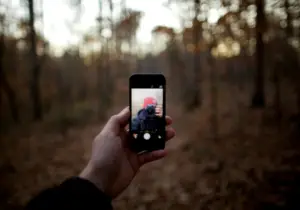
If you are a photographer (or videographer/cinematographer), vlogging about the process of your photography is almost a behind the scenes video itself. But it doesn’t necessarily have to be a “second channel” thing, in reality. There are many photographers out there who vlog regularly about their photography, creative process, gear, techniques, and more. Think of this as more of a “photographer’s lifestyle vlog.”
Review and unboxing vlog
Here’s another one that can be as broad or specific as you want it to be. Buy something you like? Unbox and review it! Order something out of curiosity? Bring your viewers on the journey!
YouTube is now one of the first places people look for reviews on products, so this is a pretty popular niche regardless of what you’re actually reviewing. Some people will review anything and everything, others will stick to a certain category–toys, makeup, tech, food, etc.
This is also another category that can be rolled up into another more targeted vlog style, such as lifestyle, photo, tech, or others. We don’t necessarily feel that a review channel is the same as a vlog, but vlogging can definitely include a good number of review videos. If that makes sense.
News (tech/pop culture/gossip) vlog
Vlogs can sometimes cross defining lines of genre, and this is a great example of that. Vlogging about news stories in a variety of topics and categories has proven popular, and there seems to be a new resurgence in topical news shows coming out on YouTube these days.
News/gossip vlogs can be as professional and polished as the general news channel The Philip DeFranco Show or the tech news show Front Page Tech (FTP? Professional? Hah! Nah, jk there, Jern!). They can also be as raw as sitting in front of your webcam and ranting about some dumb stuff that just grinds your gears for five minutes.
While, yes, this does somewhat stretch my definition of “vlogging”, it also technically fits. And if you have opinions about a niche you are passionate about, it could be an excellent means of getting your ideas out there or informing people about something that they may not have otherwise learned about.
Family vlogs
For those who are either just starting a family or already have one, a family vlog may be a fun hobby to document the growth of your kids as well as share how you get over the many hurdles of parenthood. Not only will you archive treasured videos of your children throughout the years, but you’ll also be creating some fun stories for years to come.
Some people, however, may not feel comfortable sharing their lives (especially their kids’ lives) on YouTube, however, so this may not be for everyone. Not to say that either of these opinions are right or wrong, as the morality that goes into that choice is quite nuanced.
It’s definitely a personal family choice to make. Our opinion is that as long as no one is being hurt or exploited, you should do whatever you feel is right for you. Be mindful of your audience and how they may be consuming your videos and make sure you’re always putting your kids and family first.
Picking the best vlogging equipment for you
The great part about vlogging is that you don’t necessarily have to focus on gear nearly as much as you would for another type of video series. People do come to expect a certain level of quality from YouTube these days, but will be more forgiving of less than stellar lighting and audio from a vlogging channel.
This is usually because vlogs are very much an on-the-go style of storytelling. You’re out and about running errands, going to gigs, or buzzing around the house completing projects. You can’t always bring around a giant camera, tripod, and lighting, so there’s a trade-off there.
But that’s a good thing, really. The less the gear gets in your way, the more likely you are to just make something fun. And making something fun is what vlogging is about, right?
You shouldn’t need to stress about what video camera you’re going to use when you get started vlogging. A flip screen and wide-angle lens are enough to get you started for sure.
Thankfully, you can absolutely get high quality video from even your phone with very little effort. Whether you’re using an iPhone or small DSLR or mirrorless camera, almost any camera makes an excellent vlogging camera, so don’t let that stop you from making videos.
That said, you still need some gear, and the choices are quite plenty. In a previous version of this guide, we’ve had a huge list of vlogging cameras, equipment, and accessories. In order to make this guide more streamlined, we’re moving that into their own guides, but here’s the quick version.
Cameras for vlogging
While you can technically use any camera for vlogging, there are specific features that you’ll want in a vlogging camera, and others you won’t need. Our short list of vlogging camera features consists of:
- A wide-angle lens
- Flip out or flip-up screen
- Reliable autofocus
- Solid stabilization
- Microphone input
- Hot shoe mount
You’ll find that most cameras have some of these, but maybe not all, or not the ones that are most important to you. We’ve put together a comprehensive guide to the best vlogging cameras available today where we look at our top suggestions as well as why you need certain features if you want further details.
Best video editing software for vlogging (the professional/popular standards)
After you’ve shot your video, you usually need to then put everything together, edit out the parts you aren’t keeping, clean it up, and get it ready for upload. For that, you need some editing software.
There are a ton of options out there on every platform, and there is really no “right choice” as it very much comes down to personal preference. Our particular favorite happens to be the free Davinci Resolve (more details below, but that’s not to say it’s far and away better than, say, Premiere Pro.
Computers and laptops
It doesn’t really matter too terribly much as to which kind of laptop you’re using, especially when you first start out. There are some excellent video editing laptops on the market, but you won’t need to worry too much if you’re just doing basic and light editing here and there.
As with most things, once you get more involved and your needs increase, you can look at getting a new laptop or desktop, along with external SSDs for video editing so you don’t run out of internal storage space when it’s time to copy over that next big video file.
On Windows, you can use the free Windows Movie Maker (version depends on which version of Windows you have), and Macs have iMovie included, both of which will get the job done.
Editing on mobile devices
There are a metric ton of mobile editing apps, and to be honest, they’re a bit hit or miss. There’s Adobe Premiere Clip, Adobe Premiere Rush, as well as FilmoraGo, KineMaster, and many others.
Unless you’re on a more modern iPad, we wouldn’t advise using one of these unless you’re away from a computer and really need to get something posted. It’s just much easier to use a desktop app.
But we get it. If you don’t have a desktop/laptop (or yours can’t process video playback too well), mobile video editor apps will allow you to get your videos edited and exported for upload in times of need.
Final Cut Pro X
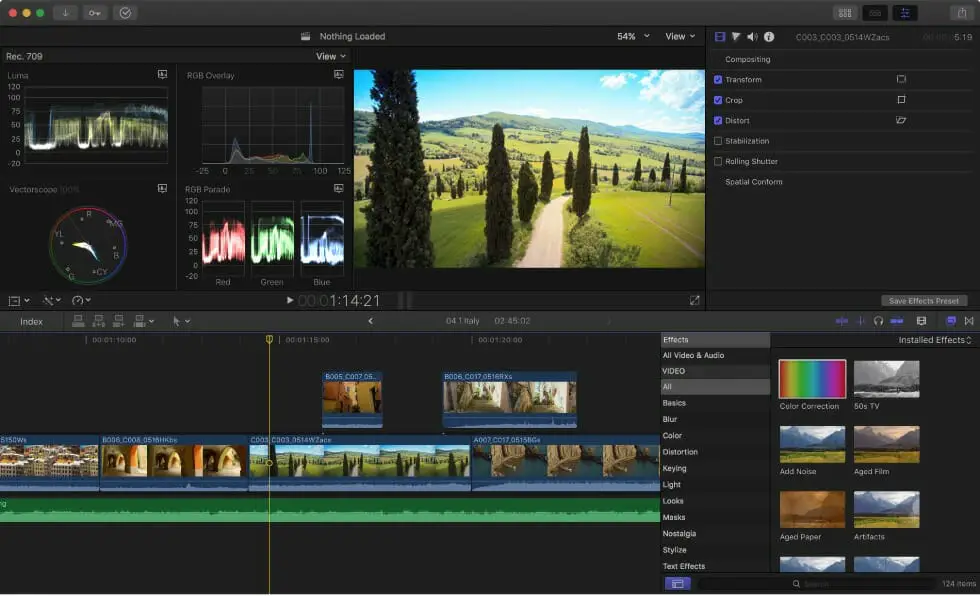
If you’re on a Mac, you may naturally gravitate to Apple’s Final Cut Pro X. This is a professional (non-linear editor) and is very popular because of its ability to work with large files quite quickly, whereas others may stutter during timeline scrubbing, playback, editing, and exporting.
Even on the old Mac Pro, Final Cut can scream through media, and has a pro-level assortment of features. It’s quite different from other apps in some ways, but it’s been reworked so that if you graduated from iMovie, it will feel very familiar.
Adobe Premiere Pro
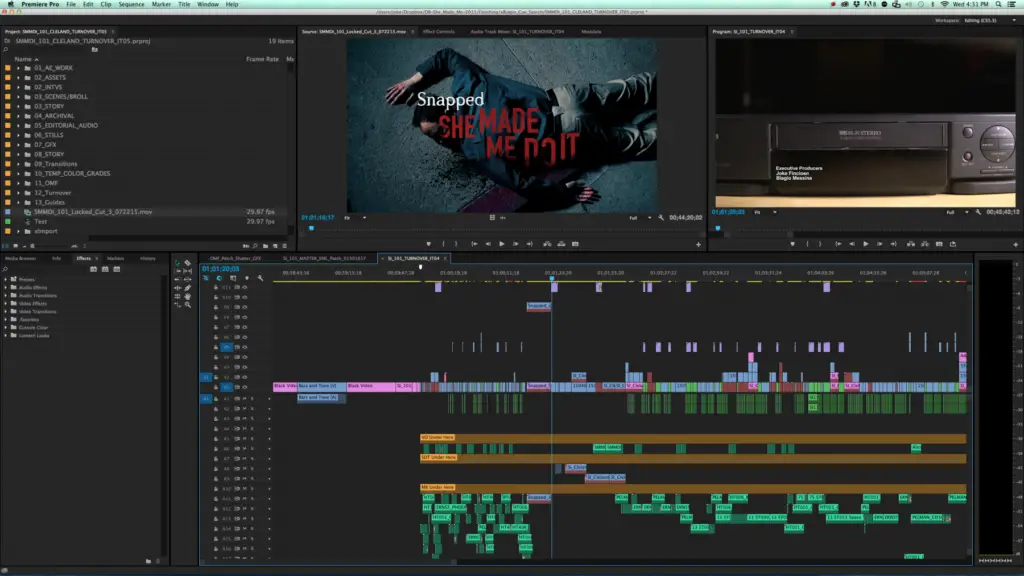
The de facto video editor of choice across both Windows and Mac would be Adobe Premiere Pro. One of the industry standards, Premiere Pro is a professional NLE that can handle anything you throw at it.
As part of the Adobe Creative Cloud suite, the app is available in various plans and bundles to which you can subscribe. And if you want to work with motion graphics (complex titles, effects, etc), you’ll also want After Effects to go along with Premiere Pro.
There are a huge amount of free and paid resources out there for Premiere Pro and After Effects in the form of templates, motion graphics presets, title presets. If you can’t find something out there for free, you can hire people to make assets from places like Fiverr, or buy templates from Envato’s marketplace. Creative Cloud subscriptions also come with access to their library of assets as well.
Avid Media Composer
Not often an NLE thought of among casual video editors, Media Composer is an industry standard. Avid Media Composer was the editing suite in most studios and had a strong dominance in Hollywood. They then bought Digidesign, the developers of the venerable ProTools studio recording software, and they had both audio and video locked up tight.
Media Composer is mostly found in production houses and other professional environments and hasn’t really become terribly dominant in the home/consumer space, where Premiere Pro, Sony Vegas, Corel VideoStudio, Pinnacle Studio, CyberLink PowerDirector and others have traditionally thrived.
Download Avid Media Composer here
Best video editing software alternatives for vlogging (strong options against the popular choices)
Editing software can definitely get a bit pricey, going up to $50/month USD for the full Creative Cloud subscription suite, $299 for Final Cut Pro X, and even Media Composer adopting a subscription model starting at $19.99/month. If you’re looking at how to start a vlog, these prices may seem quite prohibitive.
If you can’t swing any of these, you do have other options. We previously covered these next two apps in our guide to Creative Cloud alternatives, and I like both quite a bit.
Blackmagic Design Davinci Resolve
Our first experience with Davinci Resolve was for color grading a final edit exported out of Premiere, and then round-tripping the graded results back into Premiere. There was no editing functionality at that time. Fast forward a few years, and now Davinci Resolve is a full-featured NLE that can stand toe to toe with Premiere Pro, Final Cut Pro, and the like. We’ve even made it our go-to editor of choice these days.
There are modules for media management, editing, color grading, audio mixing, and delivery of your final product (exporting). Starting in version 15, it now has their motion graphics application, Fusion, built in. This allows you to take a clip from your timeline and directly work on graphics, titles, and compositing without leaving the application. This is a huge timesaver for titling and clever edits and other tricks.
And one of the best parts about Davinci Resolve is that it’s free. There is a studio version if you need higher end professional features (like certain 4k features and noise reduction in the Color tab), but instead of costing thousands like when I used it last, it’s now a mere $300.
All this adds up to a very powerful, professional editing and grading suite that either costs nothing or not much at all, depending on your needs. I’ve recently moved back to Davinci Resolve as my main editor of choice, as for my needs the editing features have me covered and I don’t need to round-trip anything from one app to another for complex grading.
You definitely can’t go wrong with giving Davinci Resolve a try, however, note that with older graphics cards you may not be able to run the app due to CUDA version requirements. Anything from the past few years should be good, and even the Intel integrated graphics as far back as the 5500HD should allow it to launch (it just won’t perform too well on that one).
Download Blackmagic Design Davinci Resolve here
HitFilm Express
HitFilm is one of those free editing applications that just really works well and is excellent for beginners.
Like Davinci Resolve, HitFilm is a full-fledged NLE, as well as a motion graphics/compositing suite all in one package. You can edit and make your complex graphics without ever leaving the app. It’s free for the base version, and the paid version offers many more features–again, like Davinci Resolve.
I don’t feel that HitFilm feels as “professional” as Davinci Resolve or Premiere Pro, but it’s still extremely powerful. The editor is polished and works well, albeit in the free version it lacks some of the niche tools that users from other platforms may sorely miss.
If you’re looking for something a bit less intimidating than any of the flagship NLEs, HitFilm is a great choice and will serve you well for a long while.
Which video editing software is best for vlogging?
All of them, really. Personally, we’re a huge fan of Davinci Resolve because the free version is probably the most powerful and flexible of the bunch, and the upgrade path to the Studio version is ridiculously cheap now. It handles pretty much any video format you throw at it with ease.
That said, we also do really love the Adobe Creative Cloud software, Premiere Pro and After Effects make a great team, and Media Encoder is much more useful than most people give it credit.
If you’re just starting out, it doesn’t really matter. All of these will let you make some high-quality videos without a huge price tag. Go with the cheaper (or free) option–if you stop vlogging or creating videos, no sense in continuing to pay for something you don’t use.
Also, if you have friends who have a YouTube channel or otherwise edit video and you like their workflow and style, look into what they use and get their advice. Having a support network of experienced peers to help is also a great thing to lean on.
But if we were pressed for an answer for someone looking to start on the cheap, but was serious about continuing video production work, we would suggest Davinci Resolve because of the price (or lack thereof), or Adobe Premiere Pro for the vast amount of resources that exist for the platform, such as templates for both Premiere Pro and After Effects.
Vlog editing and pacing
Just shooting footage isn’t enough for a compelling story. Your editing needs to tell a story in a manner that keeps the viewer enthralled and not bored. This is predominantly a combination of content and pacing and does have a bit of a learning curve.
Typically, vlogs are somewhat quick in pace. Trying to keep the flow smooth without a bunch of dead air, so to speak, is critical to ensuring that the viewer won’t be bored and click out of the video.
When you first get started and you’re making your first vlog, you may not have much of a game plan while shooting, or may not know how what you shoot translates to in the edit. But worry not, it’s definitely a learnable skill.
You’ll also want to start thinking about “shooting for the edit”. This means that when you shoot b-roll you’re already planning out ways that this will be cut together in the video. Sequencing transitions with certain camera movements in and out of a clip, getting alternate a-roll takes depending on certain editorial choices you may need to decide further down the line, ensuring that you have all the coverage for your planned edit. It’s definitely not second nature to start, but you’ll get there.
You’ll find that you end up using much less of your b-roll than you think, and when you film 5+ seconds of something it may end up only being used for 2 seconds or less. Cutting together the b-roll in a tight fashion, along with editing the dialog to be concise, is what will help give a sort of snap to your videos. We often think of some sequence of cuts as a percussive feel, especially when cutting to the beat of the music in your videos.
Upload schedule and video length
With how the YouTube algorithm has been working (or not working, depending on who you ask), this is a bit of a murky subject, however, a few basic truths have come to be widely accepted as requirements for your upload schedule and length of your videos.
Now, of course, any and all of this information is subject to change with or without anyone knowing it, so this is just based on knowledge at the time of writing this.
What is the best length for a vlog video?
Many have found that the algorithm favors videos at least 10 minutes in length, as these tend to get fed to other users in the Recommended feeds more often. This is usually because it will keep users on the site longer, and contribute to higher watch time for channels. It also helps retention because it’s not too terribly long, and is easily digestible. As a result, creators have noticed that their Adsense revenue does a bit better after that 10-minute mark. That’s the short version.
You can definitely upload longer videos into the 20-30 minute and higher range, and this will absolutely help your watch time. It may also hurt your watch time ratio, as people bail halfway through a video. But if you have a particularly dense or involved topic, 20-30 minute videos often can’t be avoided, and shouldn’t be looked at as terrible. They’re just not typically conducive to a vlogging format.
If you aren’t sticking to a real-time sort of daily vlog format you could possibly break your longer 20-30+ minute videos into multiple uploads. Do a part 1, part 2, so on and so forth. You’ve already shot and edited the video, might as well break it into multiple parts and get more uploads out of it.
If you aren’t sure whether you’re going to do this or not, you can always shoot alternate dialog takes to use whether you end up doing a one-shot video or multipart upload. If you get to what might be a stopping point, just make a quick comment saying that you’ll pick up in part 2 or something, and that’s now squared away in case you make that choice in the edit. Magic!
That said, I’ve been noticing a bit of a shift in video durations recently. Many YouTube creators are opting to forego the 10-minute mark and instead are hitting around the 6-8 minute range. While this may technically harm your Adsense revenue (theoretically, who knows in actuality as this stuff is all super-secret over at YouTube), it naturally lends itself to a higher viewer watch retention rate.
Update: YouTube has now reduced the minimum length of a video to be eligible for mid-roll ads from 10 minutes to 8 minutes. This was why so many channels uploaded 10+ minute videos, but with the 8 minute requirement we’ve noticed that there are less creators padding out videos to hit that 10 minute mark.
Watch retention rate is the amount of the video that users stick around to watch, as opposed to bailing early. If someone watches 100% of your video, that is 100% watch retention. If someone bails halfway, that will hurt your watch retention rate. Average the two out and you have a 75% watch time retention rate.
This retention score is now one of the major metrics that has been contributing to YouTube placing videos in the Recommended or Up Next locations, as they want to push videos that are very likely to keep the user engaged as long as possible. If you get someone sticking around for 5 minutes out of a 7-minute video, it’s a much higher retention than 5 minutes out of a 10-minute video. As opposed to dragging out a video for the magic 10-minute mark, more and more creators are not worrying about this and posting shorter videos when it makes sense to do so.
What is the best upload schedule for a vlog?
As far as how often to upload, well, this is pretty easy, relatively speaking. Upload. Every. Day. Or, that’s what would technically be the best, according to many YouTubers. But that’s pretty difficult for the majority of people.
Thankfully, you don’t really need to upload every day. As long as you’re being consistent at least one to two days a week, you should be alright. No, you won’t get the same sort of video momentum as if you uploaded every day, but saving your sanity is a decent exchange for that in my book.
Really, the answer should be: upload as often as you can, as consistently as you can, for (maybe) at least 10-minute videos (but maybe a bit less), but not too much longer than 20-30 minutes (if the video is really needing it).
Can you make money vlogging?
So far, we haven’t really touched on the subject of how to make money vlogging, and that’s for a very specific reason. If making money is the singular goal you have while setting out to create your YouTube channel, it’s almost guaranteed not to work.
With YouTube’s change to Partnership requiring 1,000 subscribers and 4,000 watch hours, not everyone will qualify immediately. But with some effort, you can absolutely get there!
While it can be difficult to get to a profitable state, it’s absolutely possible to make money on YouTube–it’s just going to take time and effort, so keep this in mind.
Everyone wants to be a YouTube vlogger
I’m sure you’re aware that YouTube vloggers are everywhere. You’ve probably gone out to some place or event in your town and you’ve seen the typical YouTube vlogger out and about, talking to their camera, or getting some sweet b-roll. I’m sure you’ve seen it multiple times.
Those are your competition. All around the world, not just in your hometown. Think about just how many vloggers on YouTube that actually works out to be.
We’re not pointing this out to discourage you, please don’t get us wrong! It’s just the fact that YouTubers, in general, don’t automatically start raking in the thousands, hundreds, or even tens of dollars for a very long time. It’s a realistic point of view that all YouTubers and vloggers should be aware of.
Don’t do it just for the money
You’ll need to put in a ton of work, passion, sweat, and effort into your channel in order to start making any reasonable amount of money, so know that going in. Do it for the love of the game, not for the paycheck. The paycheck may follow, it may not. But if you’re having fun making cool stuff, does the paycheck necessarily matter?
That said, let’s say that your passion leads to a growing audience. You will eventually be able to join the YouTube Partner Program once you cross 1,000 subscribers and 4,000 watch hours in the previous 12 months. Now you can enable Adsense monetization on your videos. You will not make large amounts of money from this unless your videos are cracking a million views per video.
Affiliate links
Your better bet is to utilize affiliate marketing links in your video description. These can be to Amazon, B&H Photo, iTunes (just kidding, Apple axed this program during the research and writing of this post), or any other company/program that offers affiliate links in your particular video topics.
If you highlight a product or item in your video, you can always post an affiliate link in the description. This is a fairly common practice among vloggers, and your viewers usually won’t have an issue with this. Just be wise about your implementation and you should have any issues.
For example, we utilize affiliate links to support the site and be able to bring new videos and do more reviews. We typically try not to use these links for products we don’t believe in to ensure that we’re not putting out bad information.
Sponsors
Eventually, as your audience builds and your authority online grows, you may attract companies that want to sponsor your videos. While this may be very exciting when it first occurs, you should approach this very cautiously.
Once you start accepting sponsors for your videos, you quickly change your perception to your viewers. If you’re accepting literally any sponsor that approaches you, you may be alienating your viewers and coming off as a shill.
Viewers understand that creators need to pay the bills, but there are a right and a wrong way to go about it, and using sponsors that aren’t related to your videos or your life make it clear that you care more about money than your viewers. This is a quick path to lose subscribers and authenticity.
General guidelines
You do need to follow certain disclosure and ethics rules around affiliate links, sponsorships, and other forms of income, but it’s not difficult and doesn’t really impact your ability to earn. You just want to always be honest and upfront to your viewers.
Accept pertinent sponsors, don’t affiliate link things that don’t matter, and don’t forget that your audience watches you because you provide value to them. Reread that last part, and keep it burned into your brain.
Always do your best to maintain transparency with your viewers if you make money by monetizing certain aspects of your YouTube channel. If something feels shady, probably shouldn’t go through with it. If you need to clarify things, err on the side of caution. Provide value to your audience and they will return that value by way of utilizing your links and sponsors.
Vlogging tips
Now that we’ve covered most of the technical components of vlogging, let’s go over some tips to get you off and running!
- It may sound odd coming after that last bit, but don’t let the technical parts get in the way of telling your story. If all you have is your phone, use it. Vlogging is usually a forgiving genre of video, as long as your story is entertaining.
- Story, story, story! You may not immediately think so, but the best vlogs follow the traditional narrative mechanics, such as setup/conflict/resolution, or even the story circle. Find your narrative in the daily or weekly activities and tell it.
- It’s difficult to talk to a camera when you first start. Especially in public with random people all around you, possibly judging you. The key is to not talk to your camera, but your audience through the camera! You’re talking to the viewers on YouTube directly, not a hunk of glass and metal.
- Content is king. If you have a great story to tell, people will enjoy it. That said, some people say…
- Personality over content. Vlog audiences are usually more interested in the person doing the thing rather than the thing the person is doing. Vloggers are the attraction, not the events. That said, I don’t always believe in this and instead feel that…
- Personality is half of content! Let’s be honest, even if someone you really like has a vlog, how often are you going to watch if there’s nothing going on except incessant ramblings? You need both halves to create a great story. Show your personality while doing entertaining things.
- Look at your daily routine to find ideas to work into your vlog. Things that are already part of your schedule or are schedule-adjacent are easiest to lock down in a video.
- Look at your commute to see what sort of locations you can shoot video in. Do you walk to work? Bike? Boosted board? Drive? What stops can you throw in to shoot, or quick little fun bits can you include in your videos?
- Is your day job one that you can shoot during? If you’re an office worker or retail employee, probably not, and likely will land you in trouble–especially if you work in a secure environment. But if you’re more of a freelancer or participate in what is now being referred to as the “gig economy”, you can get away with quick bits here and there.
- Vlogs often will require planning and effort. Not always, but don’t lose sight of the fact that you will have to work at putting together a fun video.
- Collaborate with other local vloggers! If you don’t have friends who already have a channel, find other vloggers in the area and make some new friends! If your friends vlog, orchestrate collaborations with them. Make sure that for the content they provide you on your channel, you’re reciprocating content for their channel.
- Use Twitter and Instagram to find other vloggers and YouTubers! Don’t fangirl/fanboy out on them, of course, but start following people in your area you look to as inspiration or entertainment and join in their conversations. Again, not annoyingly so, but just as one person connecting with another person.
- If you’re going out and doing something (especially if you plan on vlogging it already), announce it on Twitter. If you’ve picked up some new vlogging followers, you may be able to get a good crew out for a fun evening, benefiting everyone’s channel. If not, your followers may see something that interests them and they’ll look out for it on your channel.
- Last of all, don’t run yourself into the ground. Don’t do more than you can handle, and start off slowly if you need to. Burnout is a real, serious problem with YouTubers and vloggers, so don’t set some outrageous goal and beat yourself up if you can’t meet that goal. Don’t say “I’m going to start vlogging every day! And also teach myself how to edit at the same time! And also post every day!” There’s no way this can end well.
Final thoughts
Vlogging is a fun way of telling your own story in a free-form manner. It opens up a world of possibilities that aren’t available with typical video content creation. It’s not for everyone, but anyone can definitely do it. Whether you’re doing daily vlogs, weekly vlogs, or something like a behind the scenes vlog for a main channel you have the opportunity to share your story in a very personal and intimate setting that you can’t get from typical polished scripted or “main channel” videos.
As you go off and start your first vlog, just remember that you’re telling your story, connecting with your followers, and bringing them along with your journey. Keep them entertained and they’ll stay for the ride.


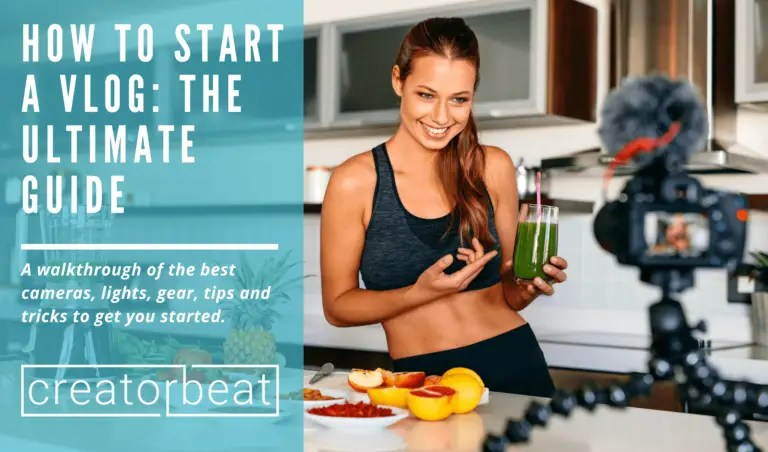
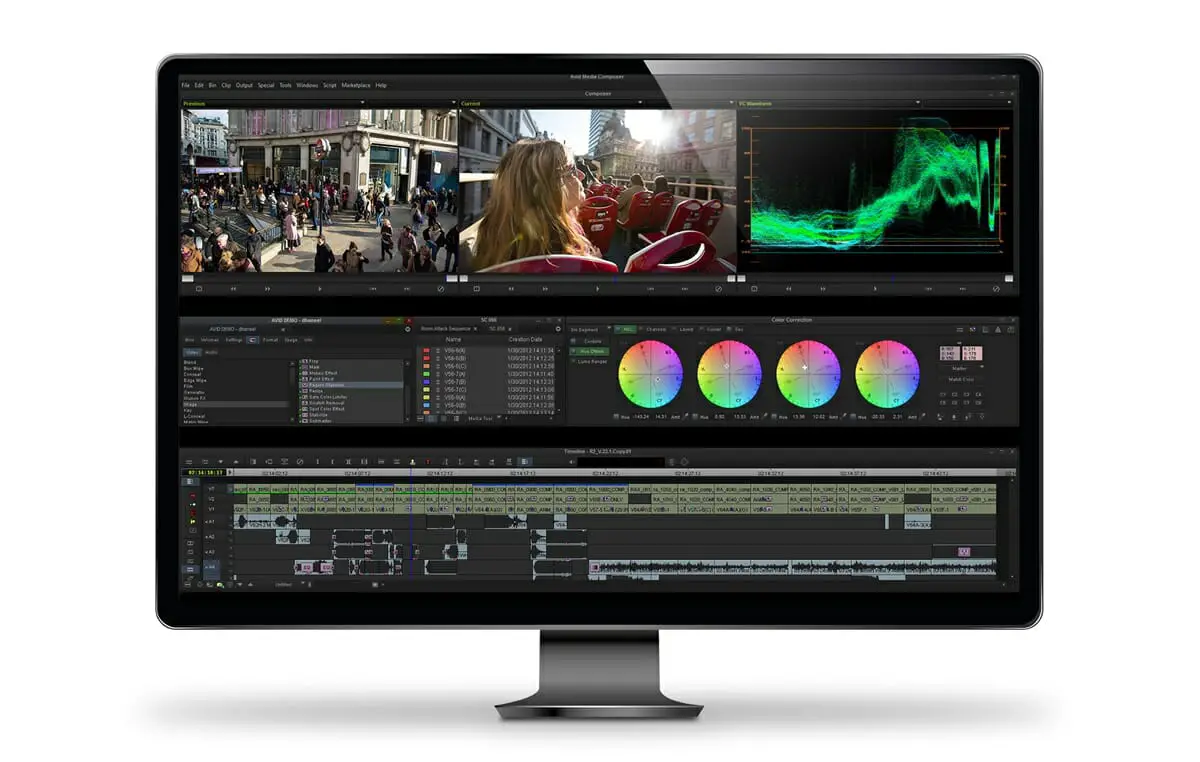
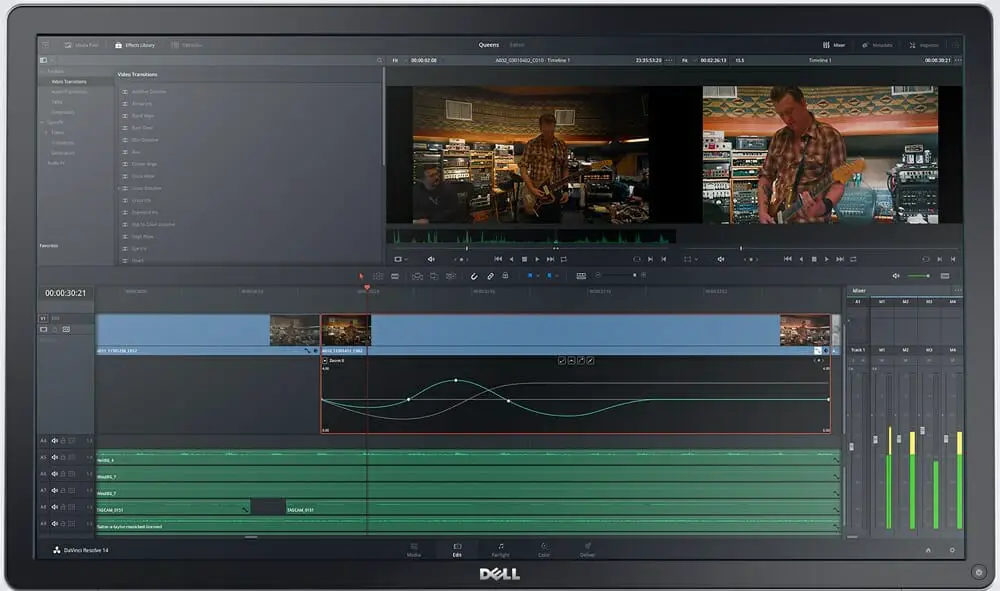
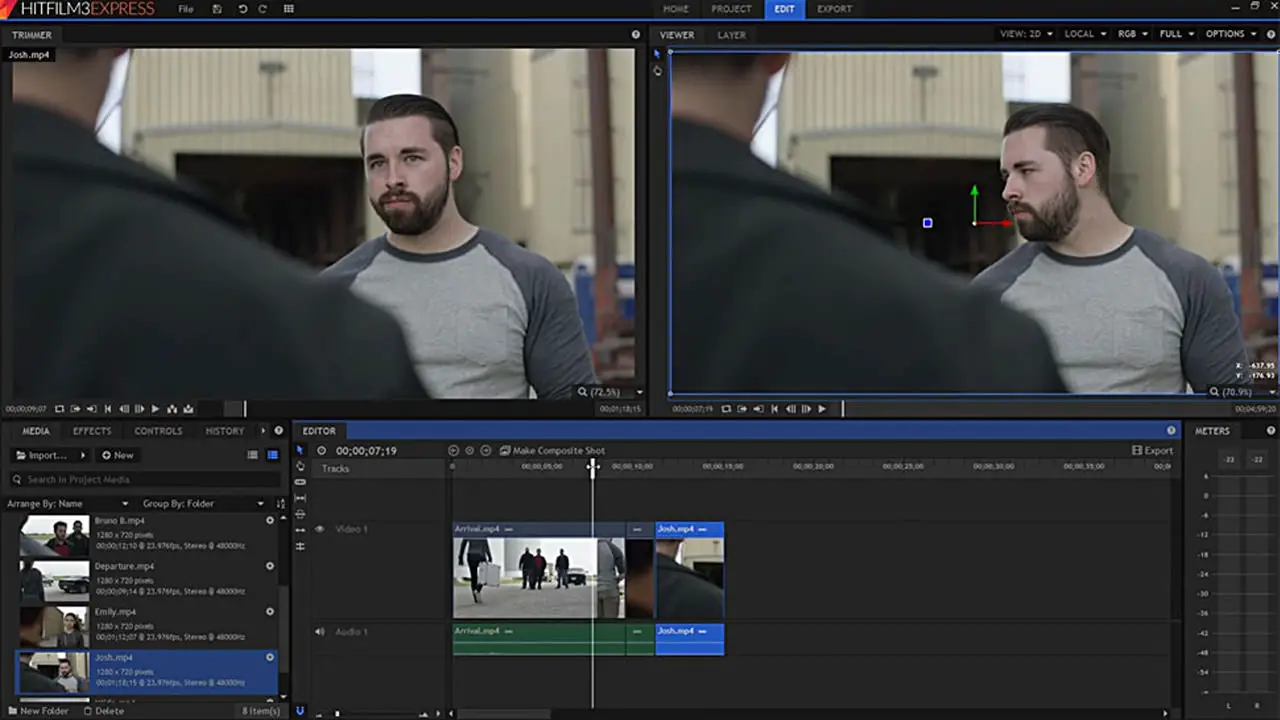
![How to make money on YouTube [2022]](https://www.creatorbeat.com/wp-content/uploads/2020/09/Creatorbeat-How-to-make-money-on-YouTube-blog-265x149.jpg)
![How to create a YouTube channel [2022]](https://www.creatorbeat.com/wp-content/uploads/2020/09/Creatorbeat-How-to-create-a-youtube-channel-blog-265x149.jpg)

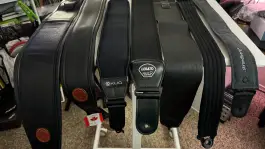
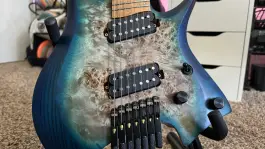
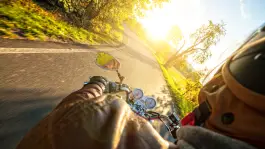

0 thoughts on “How to start a vlog: The ultimate guide [2022]”